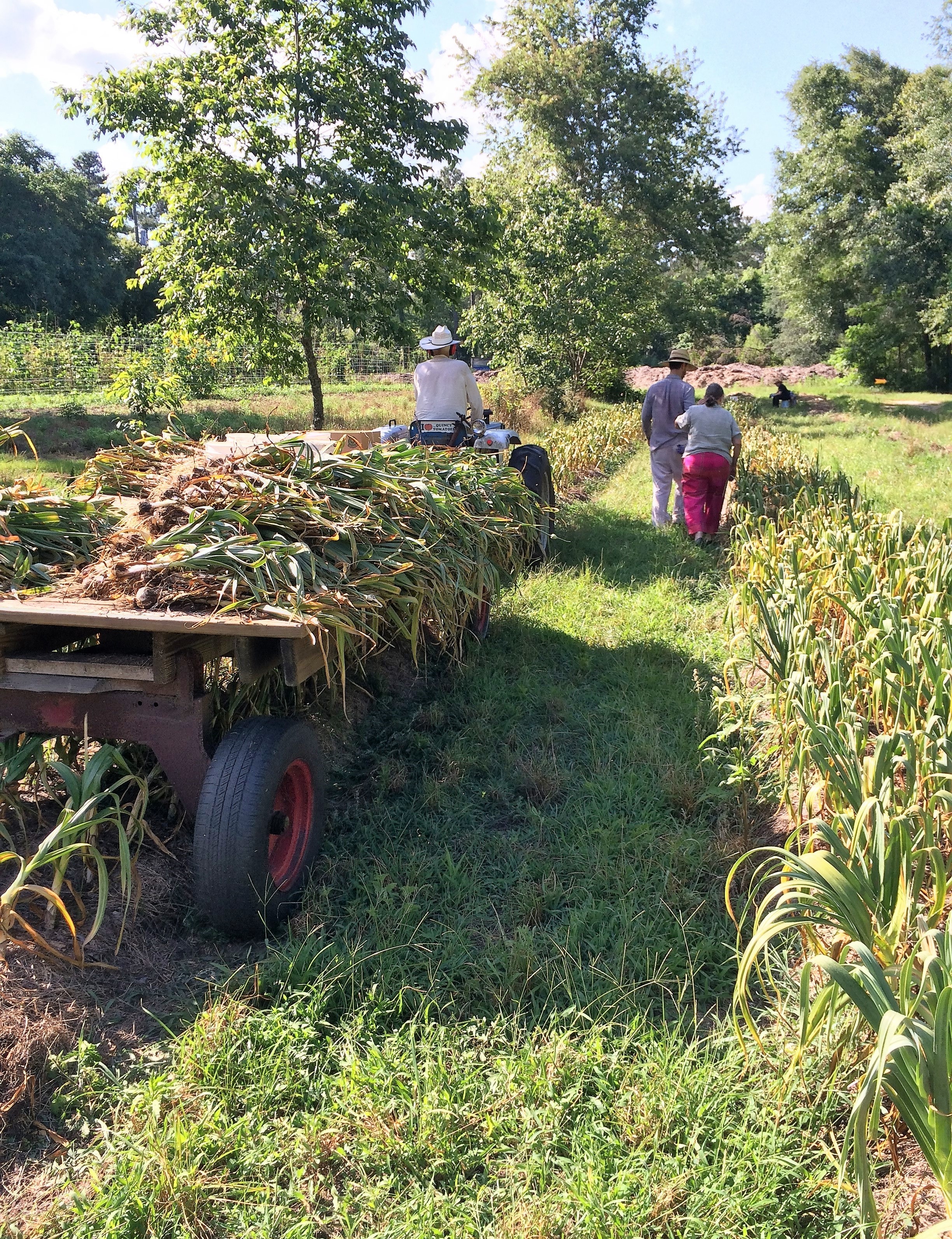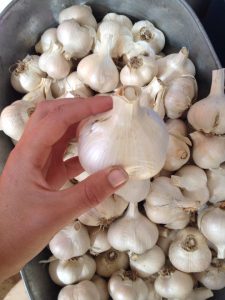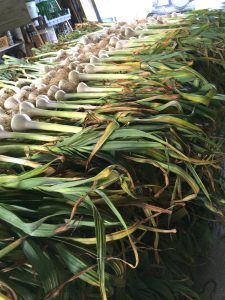
Elephant garlic grows well in our climate, including here at Turkey Hill Farm, where it is being harvested in late spring. Photo by Molly Jameson.
One of my all-time favorite vegetables to grow and eat is elephant garlic. While related to garlic, elephant garlic (Allium ampeloprasum) is actually considered a bulbing leek. Like garlic, it is in the genus Allium, a family of flowering plants that includes over 600 different species of onions, leeks, and garlic that are native to many parts of the world, including North America, Asia, North Africa, and Europe.

Elephant garlic is more mild tasting than regular garlic and can grow up to three times larger than regular garlic bulbs. Photo by Full Earth Farm.
Elephant garlic is very much garlic-like, but it has a milder, slightly sweet flavor and can grow up to three times the size of regular garlic bulbs. It is well-suited for growing in the Florida Panhandle, as it can take our heat and humidity much better than regular garlic.
Elephant garlic is a long season crop, requiring eight months for best results. It therefore should be planted in the fall for an early summer harvest. But if you just can’t wait, you can plant it now and still harvest this summer, but the garlic you harvest will most likely be one big round bulb instead of a bulb that can be separated into cloves.
When planting your elephant garlic, choose a location that receives full sun and has well-drained, nutrient-rich soil. When you are ready for planting, separate the individual elephant garlic cloves from a bulb and plant each six-to-eight inches apart, with the pointed end facing up. Cover the cloves with four-to-five inches of organic-matter-rich soil, and water well. Elephant garlic requires consistent moisture, so be sure to water your plants regularly, especially during any dry spells.
One of the unique features of elephant garlic is that it forms a tall, flowering stalk, or “scape,” in the spring. To encourage the plant to focus its energy on bulb development, remove the scapes. The top of the scape contains an edible round composite flower head that you can enjoy in salads or stir-fries.
As your elephant garlic plants mature, you’ll notice that the bulbs start to grow larger, the leaves that wrap the bulbs will decrease, and the tops will begin to turn a lighter green or yellow as they begin to die back. This is a sign that your elephant garlic is ready to be harvested. To harvest, gently loosen the soil around the bulbs with a potato fork and carefully lift them out of the ground.
If you planted late, or your elephant garlic experienced water or nutrient stress, you may still find that some of your harvested garlic only formed one big round bulb. You could leave these giant bulbs in place, and they should turn into cloves the following year. Or go ahead and harvest the big bulbs and use them in the kitchen just like you would regular garlic cloves.
Once harvested, you’ll need to cure your elephant garlic before storing. To do this, lay the bulbs out in a single layer on a dry, well-ventilated surface for at least a week. After the bulbs have cured, you can trim the roots and store them in a cool, dark place for up to eight to 10 months.
While elephant garlic may not be as pungent as regular garlic, it grows much better in our climate than regular garlic, and it still packs a flavorful punch, adding a unique twist to any dish. So why not give it a try in your garden? With a little care and attention, you’ll be enjoying home-grown elephant garlic in no time.
- The Dirt on Compost: Hot and Worm Composting at Home - October 30, 2025
- Fall Gardening Spotlight: Collard Greens - October 3, 2025
- Dung Beetles of the Florida Panhandle - June 26, 2025

